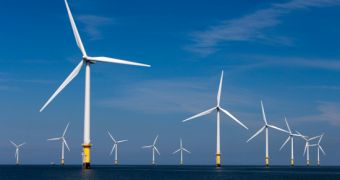Yesterday, the European Wind Energy Association released a new report documenting the evolution of the wind energy industry in this part of the world in the year 2013.
According to this report, a record number of offshore wind turbines were connected to the European grid last year.
Specifically, a total of 418 such installations whose combined energy generating capacity amounts to 1,567 megawatts went online, Click Green reports.
Of these wind turbines, 72% sit in the North Sea. The Baltic Sea and the Atlantic Ocean house 22% and 6%, respectively, the European Wind Energy Association details.
As far as suppliers are concerned, it would appear that Siemens is still a favorite, meaning that wind turbines produced and marketed by this company account for 1,082 megawatts of Europe's new offshore wind energy capacity.
BARD is the second favorite, with 240 megawatts, and Vestas and Senvion follow closely after, with 123 and 111 megawatts, respectively.
Of the new capacity, 47% was installed in the United Kingdom. Denmark contributed with 22%, and Germany is to thank for 15%. Lastly, Belgium is said to be responsible for 12% of the added wind power.
The specialists who worked on the Association's report say that, when compared to how much offshore wind power capacity was connected to the grid back in 2012, the figures documented in 2013 represent an increase of over 30%.
They go on to argue that, for the time being, offshore wind turbines in European waters can roll out some 6,562 megawatts.
This electricity output is due to 2,080 wind turbines that are currently operational, and can meet about 0.7% of the European Union's member states' demand.
Justin Wilkes, the CEO of the European Wind Energy Association, says that, in order to continue developing, the wind industry in this part of the world needs high officials to agree on an ambitious renewable energy target for 2030.
“An ambitious decision on a 2030 renewable energy target by the Heads of State in March would be the right signal to send to the offshore wind sector that Europe will develop its massive offshore wind potential for green growth, jobs, industrialisation, technological leadership and CO2 reductions,” he said.

 14 DAY TRIAL //
14 DAY TRIAL //